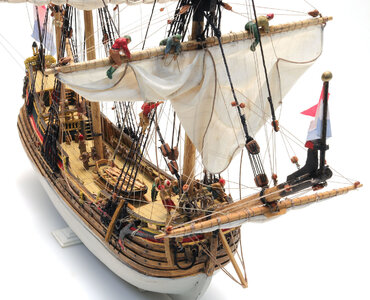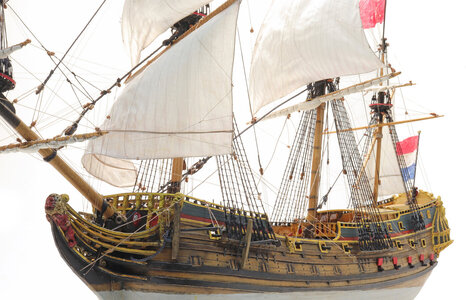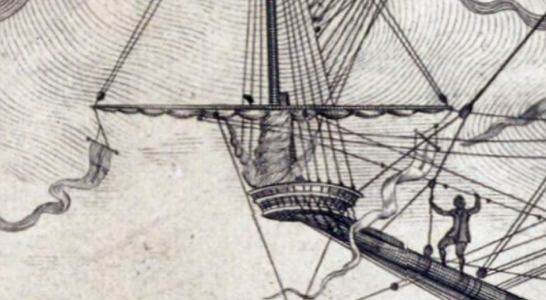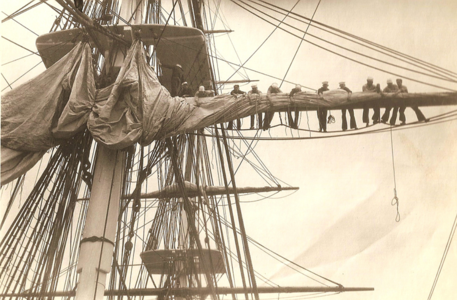Could someone tell me what material to buy to make sails? And where it might be available. Thank you.
You are using an out of date browser. It may not display this or other websites correctly.
You should upgrade or use an alternative browser.
You should upgrade or use an alternative browser.
I used "stretch satin" cloth. It is cream in color, and 97% cotton, 3% spandex. The sails are sewn, with bolt rope added, then stained, then soaked wet with starch, and allowed to dry on a jig that uses sandbags or Ziplock bags filled with water to stretch them out into a billowed shape and allowed to dry. Read how to make sails from my build log below. It's easier than you think.
Making Sails for La Couronne
Making Sails for La Couronne
Thank you Kurt.
This we discussed once in detail and at this time we agreed, that the sail material our friend @Ab Hoving is using on his amazing models is one of the best possible
Here some examples of his models



 www.whaleys-bradford.ltd.uk
www.whaleys-bradford.ltd.uk
Here some examples of his models



Navara Fine Lawn White
A light weight Cotton, slightly finer than a standard lawn quality.Fabric is prepared for dyeing and/or printing.Approx 70gsm.
Thank you Uwek.
Thank you BRadek, but I'll make the sails.
1. You can buy muslin at Joanne's stores. the lightest muslin suitable for sails is in the 65 grams per square yard.
2. the procedure is to buy the smallest piece of material you can. Take it home and weight it. Figure the weight and see what you got. Keep doing it until you discover a bolt that is about 65 grams and then buy about 10 yards of it (enough for a lifetime).
3. Another good source of material is at yard sales, liquidation sales, etc. You can buy old sheets, handkerchiefs, and other cloth items that have been washed a hundred times. I have enough old "snot rags" to build a dozen frigates. It takes time to do this selective shopping, but once you get 10 yards or so, you have enough for a lifetime.
4. There is no company that manufactures material that you can buy new that fits the scale of model sails; everything is an approximation, so get used to it. The reality is just that some approximations are better than others. The"manufacture" of muslin is another very long story' too long to write about here and to go into in this format. Muslin is the worst, BUT, it may be your only option. You have to study muslin and learn its' characteristics in order to master its' use for sails.
2. the procedure is to buy the smallest piece of material you can. Take it home and weight it. Figure the weight and see what you got. Keep doing it until you discover a bolt that is about 65 grams and then buy about 10 yards of it (enough for a lifetime).
3. Another good source of material is at yard sales, liquidation sales, etc. You can buy old sheets, handkerchiefs, and other cloth items that have been washed a hundred times. I have enough old "snot rags" to build a dozen frigates. It takes time to do this selective shopping, but once you get 10 yards or so, you have enough for a lifetime.
4. There is no company that manufactures material that you can buy new that fits the scale of model sails; everything is an approximation, so get used to it. The reality is just that some approximations are better than others. The"manufacture" of muslin is another very long story' too long to write about here and to go into in this format. Muslin is the worst, BUT, it may be your only option. You have to study muslin and learn its' characteristics in order to master its' use for sails.
I believe that muslin, being a weave, doesn't stretch much, so you can't get much billow from stretching the fabric. I could be wrong... just going from how my muslin shirts behave.I think the consensus at the Rocky Mountain Shipwrights is to visit a large fabric shop and ask for the thinnest Muslim they stock. I know I've been satisfied with the results
............ could be misconstrued ???I think the consensus at the Rocky Mountain Shipwrights is to visit a large fabric shop and ask for the thinnest Muslim they stock. I know I've been satisfied with the results
Thanks everyone. We do have a JoAnn's in the nearby town. I stop by and ask for stretch satin and thin muslin.
Stretch sateen is not a thin as Navara fine lawn, but a LOT cheaper, and if stained and sewn in detail, can look presentable. It just doesn't allow the fine folds which are to scale if partially furled, so it works best with sails fully filled.Thanks everyone. We do have a JoAnn's in the nearby town. I stop by and ask for stretch satin and thin muslin.
Many modelers use silkspan. At least it was popular a few years back. The stuff model airplane modelers use for covering the wings. Do an internet search to find sources...for example: https://brodak.com/silkspan-lite-white-only-2-sheets.html I use both thin cotton muslim and silkspan depending on scale. I highly recommend using Silkspan for modeling furled sails on your model.
Last edited:
I would also suggest that the “sailcloth” you can get from most ship modeling websites is not bad for sail making. I have marked and sewn decent sails with it. So I suggest the sailcloth for sale on ship modeling websites Is good for making sails. It is a thin, fine weave, muslin as good or better than you will get from fabric stores.
- Joined
- Dec 30, 2021
- Messages
- 278
- Points
- 278

Dumb question from a new comer but were sails not furled up over the top of the yards? or did this vary country to country?This we discussed once in detail and at this time we agreed, that the sail material our friend @Ab Hoving is using on his amazing models is one of the best possible
Here some examples of his models
View attachment 303193
View attachment 303194

Navara Fine Lawn White
A light weight Cotton, slightly finer than a standard lawn quality.Fabric is prepared for dyeing and/or printing.Approx 70gsm.www.whaleys-bradford.ltd.uk
NOT a dumb question! Yes, sails in more recent history were furled over the yards, and often farthelled in the past long ago. Farthelling is bunching up the center section of the sail and tying it around the mast, because the sail was sometimes too large to just gather it to the yardarm. I am not sure the time period/nationality when sails were furled atop the yards. I know some of my friends here have the answer...Dumb question from a new comer but were sails not furled up over the top of the yards? or did this vary country to country?
Last edited:
1. Uwe - exactly what is the name of the material that Ab used to make these sails and where do you buy it? I would like to acquire some of this material and do some experiments. However, I still do not know exactly what to ask for and where to go to ask for it!This we discussed once in detail and at this time we agreed, that the sail material our friend @Ab Hoving is using on his amazing models is one of the best possible
Here some examples of his models
View attachment 303193
View attachment 303194

Navara Fine Lawn White
A light weight Cotton, slightly finer than a standard lawn quality.Fabric is prepared for dyeing and/or printing.Approx 70gsm.www.whaleys-bradford.ltd.uk
2. I have a lot of materials of different types and have sewn a lot of sails, but, I have yet to achieve the look of these sails. I have the L'Hermione frigate (ancre plans) hull about planked (thank GOD) and am ready for some different tasks. Sails would fit the bill nicely.
3. Also, what is the scale and actual size of the model shown in these two fotos.
Look up at Uwe's post #4, and see the link he posted. Navara white lawn fabric comes from England. Both myself and Paul bought some to try out also.1. Uwe - exactly what is the name of the material that Ab used to make these sails and where do you buy it? I would like to acquire some of this material and do some experiments. However, I still do not know exactly what to ask for and where to go to ask for it!
2. I have a lot of materials of different types and have sewn a lot of sails, but, I have yet to achieve the look of these sails. I have the L'Hermione frigate (ancre plans) hull about planked (thank GOD) and am ready for some different tasks. Sails would fit the bill nicely.
3. Also, what is the scale and actual size of the model shown in these two fotos.










